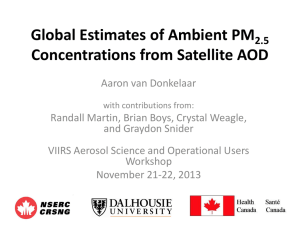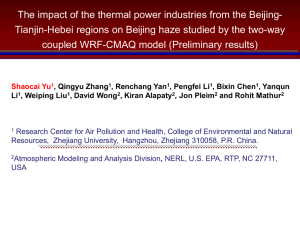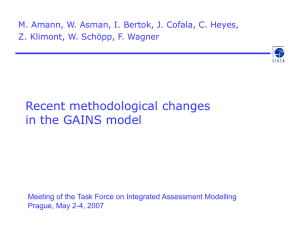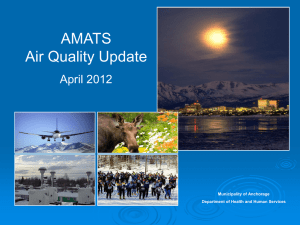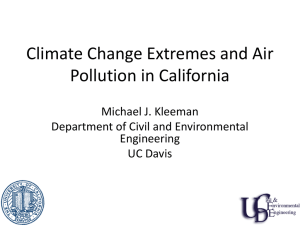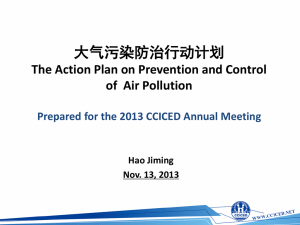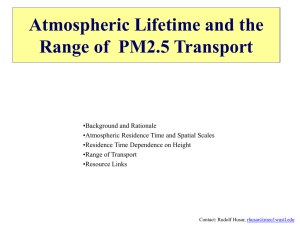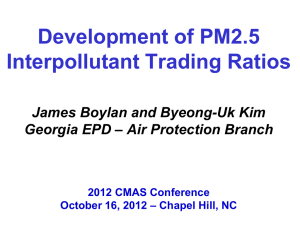Trend analysis of PM2.5 over China
advertisement
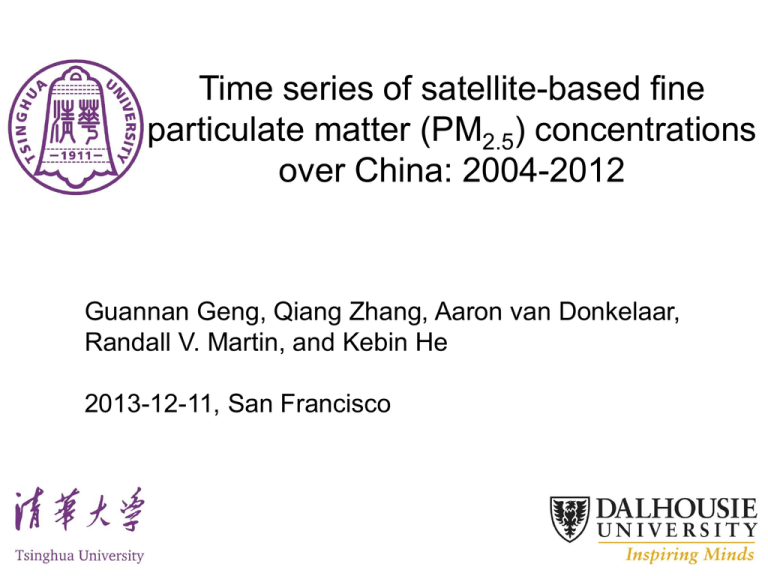
Time series of satellite-based fine particulate matter (PM2.5) concentrations over China: 2004-2012 Guannan Geng, Qiang Zhang, Aaron van Donkelaar, Randall V. Martin, and Kebin He 2013-12-11, San Francisco Sources and negative effects of fine particles (PM2.5) Health Haze Acid rain Brown Cloud fine particulate matters in the (ambient) air with 2.5 micrometers or less in size Increased morbidity and mortality from both acute and chronic exposure to ambient fine particulate matter (PM2.5) Climate Regional haze is a major concern in China Primary pollutants in 74 cities PM2.5 concentration (2013.1-10) (2013.1-10) Heavy PM2.5 pollution occurs in China, especially in the North China Plain Beijing haze How has PM2.5 evolved over the past decade over China? • Long-term variation of PM2.5 concentrations is important for epidemiological studies. • China has developed control strategies for the precursors of PM2.5, e.g. SO2 and NOx. • But ground measurements are limited in China – Only several research groups have monitored the ground level PM2.5 concentration before the year 2013. – National network of PM2.5 monitoring is built up since 2013. Satellite Remote sensing approach can be used to enhance our ability to estimate PM2.5 concentration • Many works have used aerosol optical depth (AOD) to retrieve PM2.5 concentration Multiple linear regression 𝑷𝑴𝟐.𝟓 = 𝒇(𝑨𝑶𝑫) Chemical transport model • In this study, ground-level PM2.5 concentrations for the period 2004-2012 over China are estimated using CTM to provide the conversion factor between PM2.5 and AOD. Satellite-derived surface PM2.5 MEIC MISR AOD emissions GEOS-Chem (GC) PM2.5 CALIPSO Vertical Profile AOD 𝑷𝑴𝟐.𝟓_𝒎𝒐𝒅𝒆𝒍𝒆𝒅 𝑨𝑶𝑫𝒔𝒂𝒕𝒆𝒍𝒍𝒊𝒕𝒆 × 𝑨𝑶𝑫𝒎𝒐𝒅𝒆𝒍𝒆𝒅 𝑷𝑴𝟐.𝟓_𝒔𝒂𝒕𝒆𝒍𝒍𝒊𝒕𝒆 van Donkelaar et al, EHP, 2010 van Donkelaar et al, JGR, 2013 Emission trends of the precursors in China • The MEIC inventory, 2004-2012 Evaluation of model simulations SNA simulation in the year of 2006 Slope = 0.28, R = 0.32 Slope = 0.26, R = 0.33 Slope = 0.19, R = 0.17 Slope = 0.85, R = 0.39 Slope = 0.44, R = 0.81 Slope = 0.52, R = 0.78 Slope = 0.68, R = 0.71 Slope = 0.86, R = 0.88 Modeled AOD trend compared with MISR Slope = 0.58, R = 0.66 Slope = 0.79, R = 0.82 Slope = 0.64, R = 0.49 Slope = 0.93, R = 0.74 Satellite-based PM2.5 retrieved from MISR AOD Trends of the conversion factor and MISR AOD Modeled PM2.5 Modeled AOD Modeled PM2.5/AOD MISR AOD The population weighted national annual mean PM2.5 trends over China during 2004-2012 104 PM2.5 trends of some cities in China The effect of the correlation slope between modeled and satellite AOD on PM2.5 trend 𝑷𝑴𝟐.𝟓_𝒔𝒂𝒕𝒆𝒍𝒍𝒊𝒕𝒆 = 𝑨𝑶𝑫𝒔𝒂𝒕𝒆𝒍𝒍𝒊𝒕𝒆 × 𝑷𝑴𝟐.𝟓_𝒎𝒐𝒅𝒆𝒍𝒆𝒅 𝑨𝑶𝑫𝒎𝒐𝒅𝒆𝒍𝒆𝒅 Conclusions • National scale surface PM2.5 concentration derived from MISR increased from 2004 to 2006 and started to decrease around 20062007, and had a second small peak in 2011. The trend between 2004 and 2012 was +0.5 ug·m-3·yr-1. • In the Northern China, there are mostly increasing trends, even above 4 ug·m-3·yr-1 in some regions. While in the Southern China, PM2.5 decreased in 2012 compared to 2004. • PM2.5 concentrations in some megacities have started to decrease slightly.



